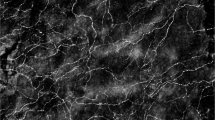Abstract
Electrophysiological techniques were used to record afferent activity in the superior spermatic nerves of young lambs under general anaesthesia. Receptive fields were identified in the pampiniform plexus and the deep tissue of the testis in response to mechanical stimulation. Application of a standard rubber castration ring to the scrotal neck evoked vigorous afferent activity, including some from formerly silent units with receptive fields particularly in the pampiniform plexus. Some of this multi-unit discharge adapted rapidly within 10 s of the application of the ring and was followed by a discharge pattern which decayed exponentially over 90 min. The rate of decay of this discharge showed more than one exponent (time constant) with inflections at approximately 90 s and 16 min. After the application of the castration ring, quantitatively controlled scrotal compression continued to excite receptors, though a declining frequency was recorded over the period of observation. It was concluded that: (a) rubber castration rings initiated afferent activity which persisted for periods in excess of 90 min, a time course which is similar to the behavioural and humoral changes in the conscious animal; (b) both standard and small rubber castration rings were ineffective in rapidly producing neuronal pressure block of the slowly conducting afferent fibres in the superior spermatic nerve; (c) intra-testicular injection of local anaesthetic rapidly blocked afferent fibres running in the superior spermatic nerve.
Similar content being viewed by others
Abbreviations
- TTL:
-
transistor transistor logic
References
Bently, F.H. and Schlapp, W., 1943. The effects of pressure on conduction in peripheral nerve.Journal of Physiology,102, 72–82
Gasser, H.S. and Erlanger, J., 1929. The role of fibre size in the establishment of a nerve block by pressure or cocaine.American Journal of Physiology,88, 581–591
Gottschaldt, K.-M., Iggo, A. and Young, D.W., 1973. Functional characteristics of mechanoreceptors in sinus hair follicles of the cat.Journal of Physiology,235, 287–315
Grubb, B.D., Molony, V. and Wood, G.N., 1990. Response of afferents in the superior spermatic nerve of rats to occlusion of the testicular artery and vein.Pain (Supplement 5), Abstract 785
Hallin, R.G. and Torebjorb, H.E., 1976. Studies on cutaneous A and C fibre afferents, skin nerve blocks and perception. In: Y. Zotterman, (ed),Sensory Fibres of the Skin in Primates with Special Reference to Man, (Pergamon Press, Oxford), 137–149
Hodgson, N., 1970. The nerves of the testis, epididymis and scrotum. In: A.D. Johnson, W.R. Gomes and N.L. Vandemark (eds),The Testis, (Academic Press, New York), 47–99
Kent, J.E., Molony, V. and Robertson, I.S., 1993. Changes in plasma cortisol concentrations in lambs of three ages after three methods of castration and tail blocking.Research in Veterinary Science,55, 246–251
Kirk, E.J., Kitchell, R.L. and Carr, D.H., 1987. Neurophysiologic maps of cutaneous innervation of the external genitalia of the ram.American Journal of Veterinary Research,48, 1162–1166
Kumazawa, T. and Mizumura, K., 1980a. Chemical responses of polymodal receptors of the scrotal contents in dogs.Journal of Physiology,299, 219–231
Kumazawa, T. and Mizumura, K., 1980b. Mechanical and thermal responses of polymodal receptors recorded from the superior spermatic nerve of dogs.Journal of Physiology,299, 233–245
Kumazawa, T., Mizumura, K. and Sato, J., 1987. Response properties of polymodal receptors studied usingin vitro testis superior spermatic nerve preparations of dogs.Journal of Neurophysiology,57, 702–711
Lester, S.J., Mellor, D.L., Ward, R.N. and Holmes, R.J., 1991. Cortisol responses of young lambs to castration and tailing using different methods.New Zealand Veterinary Journal,39, 134–138
Molony, V., Kent, J.E. and Robertson, I.S., 1993. Behavioural responses of lambs of three ages in the first three hours after three methods of castration and tail docking.Research in Veterinary Science,55, 236–245
Peterson, D. and Brown, A.M., 1973. Functional afferent innervation of the testis.Journal of Neurophysiology,36, 425–433
Torebjorb, H.E. and Hallin, R.G., 1973. Perceptual changes accompanying controlled preferential blocking of A and C fibre responses in intact human skin nerves.Experimental Brain Research,16, 321–322
Author information
Authors and Affiliations
Rights and permissions
About this article
Cite this article
Cottrell, D.F., Molony, V. Afferent activity in the superior spermatic nerve of lambs — The effects of application of rubber castration rings. Vet Res Commun 19, 503–515 (1995). https://doi.org/10.1007/BF01839339
Accepted:
Issue Date:
DOI: https://doi.org/10.1007/BF01839339




